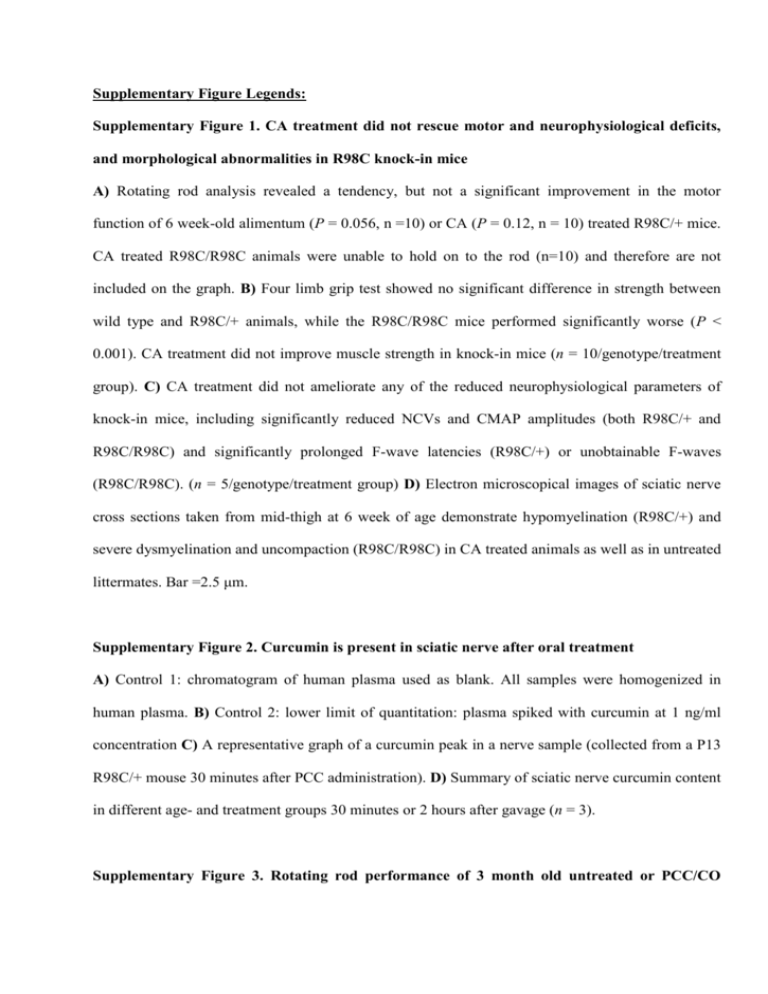Supplementary Figure Legends: Supplementary Figure 1. CA
advertisement

Supplementary Figure Legends: Supplementary Figure 1. CA treatment did not rescue motor and neurophysiological deficits, and morphological abnormalities in R98C knock-in mice A) Rotating rod analysis revealed a tendency, but not a significant improvement in the motor function of 6 week-old alimentum (P = 0.056, n =10) or CA (P = 0.12, n = 10) treated R98C/+ mice. CA treated R98C/R98C animals were unable to hold on to the rod (n=10) and therefore are not included on the graph. B) Four limb grip test showed no significant difference in strength between wild type and R98C/+ animals, while the R98C/R98C mice performed significantly worse (P < 0.001). CA treatment did not improve muscle strength in knock-in mice (n = 10/genotype/treatment group). C) CA treatment did not ameliorate any of the reduced neurophysiological parameters of knock-in mice, including significantly reduced NCVs and CMAP amplitudes (both R98C/+ and R98C/R98C) and significantly prolonged F-wave latencies (R98C/+) or unobtainable F-waves (R98C/R98C). (n = 5/genotype/treatment group) D) Electron microscopical images of sciatic nerve cross sections taken from mid-thigh at 6 week of age demonstrate hypomyelination (R98C/+) and severe dysmyelination and uncompaction (R98C/R98C) in CA treated animals as well as in untreated littermates. Bar =2.5 μm. Supplementary Figure 2. Curcumin is present in sciatic nerve after oral treatment A) Control 1: chromatogram of human plasma used as blank. All samples were homogenized in human plasma. B) Control 2: lower limit of quantitation: plasma spiked with curcumin at 1 ng/ml concentration C) A representative graph of a curcumin peak in a nerve sample (collected from a P13 R98C/+ mouse 30 minutes after PCC administration). D) Summary of sciatic nerve curcumin content in different age- and treatment groups 30 minutes or 2 hours after gavage (n = 3). Supplementary Figure 3. Rotating rod performance of 3 month old untreated or PCC/CO treated animals The holding time of PCC or CO treated R98C/+ mice was not significantly longer than that of untreated littermates. Note that treated wild type animals performed markedly worse than untreated ones. (n = 10/genotype/treatment group). Supplementary Figure 4. Partially restored thigh/paw CMAP amplitudes at 6 weeks of age in CO/PCC/CDF treated mice. A) Thigh CMAP amplitudes increased significantly in oil treated control (P = 0.022) and CDF treated (P = 0.047) mice; however, improvement was even more pronounced with PCC (P < 0.001) or CO (P < 0.001) treatment. PCC treated homozygous animals showed a tendency towards improvement (P = 0.08). B) Changes in paw CMAP amplitudes correlate with changes seen in thigh amplitudes, but might be less sensitive due to their smaller size (CO treated R98C/+ P = 0.0073 compared to untreated R98C/+, n = 5/treatment group/genotype). Supplementary Figure 5. PCC or CO treatment increases the overall number of NMJs in the soleus muscle at P13. A) The entire soleus muscle of P13 animals was sequentially sectioned and the total number of NMJs was counted on frozen sections under 20X magnification. PCC/CO treatment increased the number of NMJs in all genotypes; the results reached significance in the CO treated R98C/+ group (P = 0.03) compared to untreated R98C/+ animals. (n = 3/genotype/treatment group) B) Example of a compressed confocal image of the whole mount soleus preparation at 20x magnification. More extensive MBP labeling of nerve terminals could be observed in PCC/CO treated compared to untreated R98C/+ mice (quantification not shown), which was confirmed on TS images, where the better resolution allowed precise quantification (see Figure 3). C) Three dimensional confocal images encompassing the entire soleus muscle suggested that there were reduced numbers of NMJs in R98C/R98C compared to wild type mice at P13. Supplementary Figure 6. PCC or CO treatment did not change the expression of promyelinating or inhibitory transcription factors at P13. Real time PCR analyses of SCIP, c-Jun and Krox-20 mRNA levels and quantification of the nuclear transcription factor expression at P13. (n = 2-6/genotype/treatment group) A) SCIP mRNA levels were not significantly different in wild type and mutant animals, although nuclear SCIP positivity was higher in both R98C/+ (P = 0.029) and R98C/R98C (P = 0.049) mice, and this was reduced in R98C/+ animals by CO treatment (P = 0.029), but remained unchanged in R98C/R98C mice. B) cJun mRNA levels were markedly increased in R98C/R98C mice compared to R98C/+ littermates (p=0.012). In parallel, nuclear c-Jun positivity was also elevated in the mutants (R98C/+ P = 0.009; R98C/R98C P = 0.002). Treatment did not attenuate c-Jun activation. C) Krox-20 mRNA levels were similar in mutant animals and their wild type littermates. In contrast, immunohistochemistry revealed significantly reduced (P < 0.001) Krox-20 activity in R98C/R98C mutants, which was not ameliorated by treatment. Supplementary Figure 7. PCC or CO treatment does not reduce UPR activation at the peak time of myelination A-B) Real time PCR analyses of UPR activation and MPZ mRNA levels at postnatal day 13. (n=3-6) A) Markers of all 3 arms of the UPR (XBP1 splicing, BiP (ATF6) and CHOP) rose, but it did not reach significance. Treatment showed a tendency to further increase UPR activation. B) MPZ mRNA levels were significantly reduced in R98C knock-in animals (R98C/+ P = 0.008; R98C/R98C P = 0.013) compared to wt littermates; PCC/CO appeared to mildly increase MPZ mRNA expression. C) Western blot analysis of sciatic nerves dissected at P13. Correspondingly to the qRT-PCR data P0 protein levels were reduced in mutants (R98C/R98C P = 0.021). PCC and CO treatment increased Mpz protein levels in both R98C/+ and R98C/R98C mice. BiP protein levels were highly elevated in both R98C/+ (P = 0.001) and R98C/R98C mutants (P < 0.001) and did not decrease with PCC/CO treatment. CHOP expression was enhanced (P = 0.028) in R98C/R98C mice and was not attenuated by PCC/CO treatment. Positive control: 10-fold diluted liver samples from tunicamycin treated animals. D) Representative images of nuclear CHOP on teased fiber preparations in PCC treated animals.



![Historical_politcal_background_(intro)[1]](http://s2.studylib.net/store/data/005222460_1-479b8dcb7799e13bea2e28f4fa4bf82a-300x300.png)


